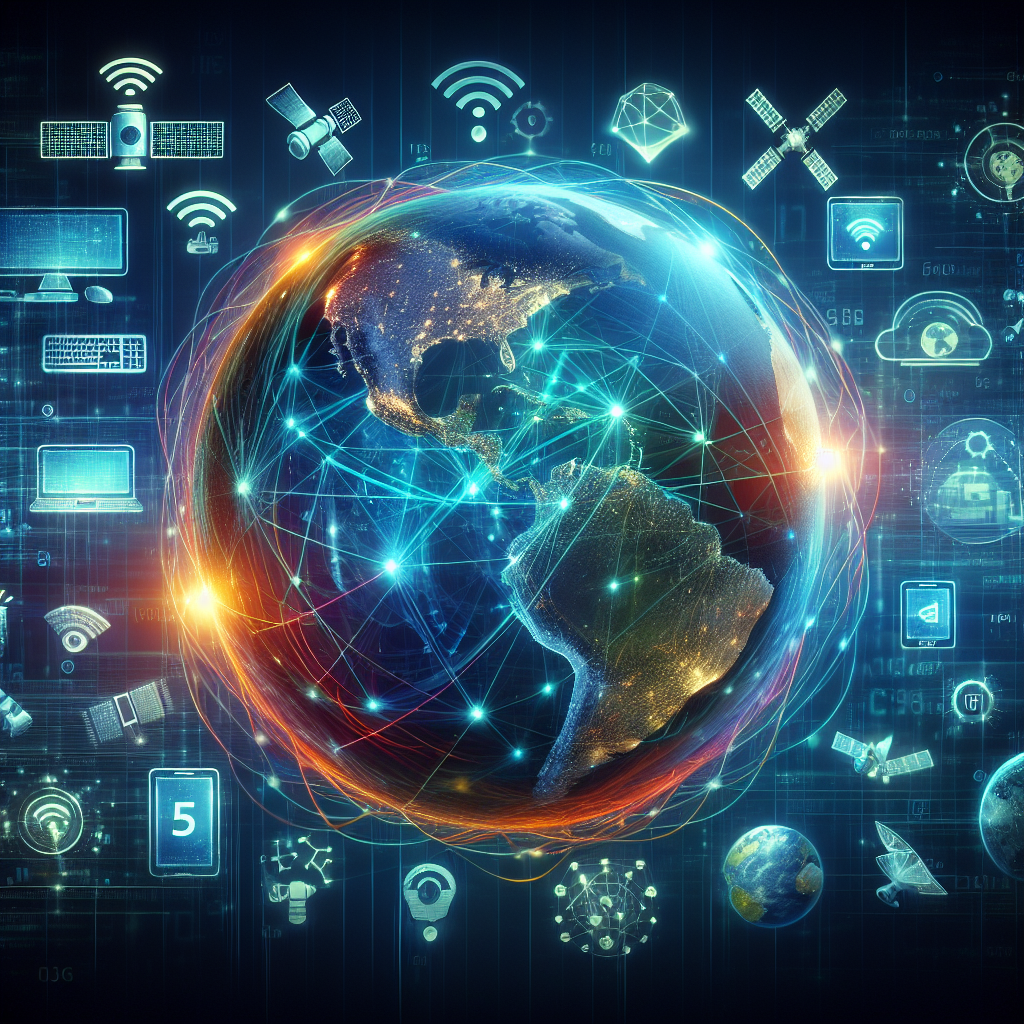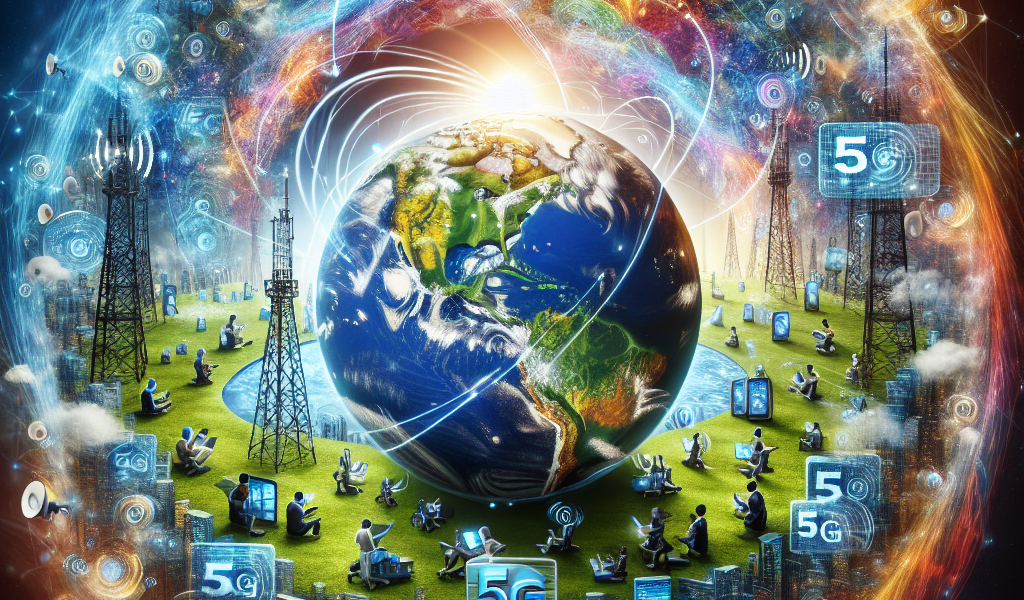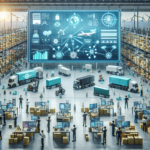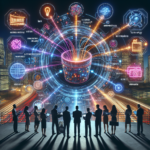-
Table of Contents
- Introduction
- Enhancing Internet Speeds: The Role of 5G in Revolutionizing Connectivity
- Bridging the Digital Divide: How 5G Technology is Transforming Remote Areas
- The Future of Smart Cities: 5G’s Impact on Urban Development and Connectivity
- 5G and the Internet of Things: Unlocking New Possibilities for Global Connectivity
- Conclusion
“Unleashing the Future: The Transformative Power of 5G on Global Connectivity”
Introduction

The advent of 5G technology marks a significant milestone in the evolution of global connectivity, promising to revolutionize the way we communicate, work, and interact with the world around us. As the fifth generation of mobile networks, 5G offers unprecedented speed, reduced latency, and enhanced capacity, enabling a new era of innovation and efficiency. This transformative technology is poised to impact various sectors, from healthcare and transportation to entertainment and smart cities, by facilitating seamless communication and data exchange. By exploring the impact of 5G technology on global connectivity, we can better understand its potential to drive economic growth, bridge digital divides, and foster a more interconnected and technologically advanced society.
Enhancing Internet Speeds: The Role of 5G in Revolutionizing Connectivity
The advent of 5G technology marks a significant milestone in the evolution of global connectivity, promising to revolutionize the way we access and interact with the internet. As the fifth generation of mobile network technology, 5G is set to enhance internet speeds dramatically, offering unprecedented levels of performance and reliability. This leap forward is not merely incremental but transformative, with the potential to reshape various sectors and improve the quality of life for millions around the world.
One of the most notable impacts of 5G technology is its ability to deliver faster internet speeds. Current 4G networks offer download speeds that average around 20 Mbps, whereas 5G networks are expected to provide speeds exceeding 1 Gbps, with the potential to reach up to 10 Gbps. This exponential increase in speed will enable users to download high-definition movies in seconds, stream 4K videos without buffering, and engage in real-time online gaming with minimal latency. The enhanced speed and reduced latency of 5G will also facilitate the growth of emerging technologies such as virtual reality (VR) and augmented reality (AR), which require high bandwidth and low latency to function effectively.
Moreover, the role of 5G in revolutionizing connectivity extends beyond individual consumer experiences. The technology is poised to drive significant advancements in various industries, including healthcare, transportation, and manufacturing. For instance, in the healthcare sector, 5G can support telemedicine by enabling high-quality video consultations and remote monitoring of patients. This can be particularly beneficial in rural and underserved areas, where access to healthcare services is often limited. Additionally, 5G can enhance the capabilities of medical devices and wearables, allowing for real-time data transmission and more accurate diagnostics.
In the realm of transportation, 5G technology is expected to play a crucial role in the development of autonomous vehicles. The low latency and high reliability of 5G networks will enable vehicles to communicate with each other and with traffic infrastructure in real-time, improving safety and efficiency on the roads. This could lead to a reduction in traffic accidents and congestion, as well as lower emissions due to more efficient driving patterns. Furthermore, 5G can support the implementation of smart city initiatives, where interconnected devices and sensors can optimize energy usage, waste management, and public services.
The manufacturing industry is also set to benefit from the enhanced connectivity provided by 5G. The technology can facilitate the adoption of the Industrial Internet of Things (IIoT), where machines and equipment are connected to the internet and can communicate with each other. This can lead to more efficient production processes, predictive maintenance, and reduced downtime. Additionally, 5G can enable the use of advanced robotics and automation, further increasing productivity and reducing costs.
While the potential benefits of 5G technology are immense, it is important to acknowledge the challenges associated with its deployment. The rollout of 5G networks requires significant investment in infrastructure, including the installation of new base stations and the upgrading of existing ones. There are also concerns related to cybersecurity and data privacy, as the increased connectivity and data transmission could make networks more vulnerable to attacks. Addressing these challenges will be crucial to ensuring the successful implementation and widespread adoption of 5G technology.
In conclusion, 5G technology holds the promise of revolutionizing global connectivity by enhancing internet speeds and enabling a wide range of applications across various sectors. Its impact will be felt not only by individual consumers but also by industries and communities worldwide. As we move towards a more connected future, the successful deployment of 5G will be essential in unlocking the full potential of this transformative technology.
Bridging the Digital Divide: How 5G Technology is Transforming Remote Areas
The advent of 5G technology heralds a new era in global connectivity, promising to bridge the digital divide that has long separated urban centers from remote areas. As the fifth generation of wireless technology, 5G offers unprecedented speed, low latency, and the capacity to connect a vast number of devices simultaneously. These advancements are not merely incremental improvements but transformative changes that have the potential to revolutionize how remote communities access information, services, and opportunities.
One of the most significant impacts of 5G technology is its ability to provide high-speed internet access to areas that have traditionally been underserved. In many remote regions, the lack of infrastructure has made it difficult to establish reliable internet connections. Traditional broadband services often require extensive physical infrastructure, such as cables and towers, which can be prohibitively expensive to install and maintain in sparsely populated or geographically challenging areas. However, 5G technology, with its reliance on wireless signals, can circumvent many of these obstacles. By deploying 5G networks, service providers can deliver high-speed internet to remote areas more efficiently and cost-effectively than ever before.
Moreover, the enhanced connectivity offered by 5G can have profound implications for education in remote areas. With access to high-speed internet, students in these regions can participate in online learning, access digital resources, and engage with educational content that was previously out of reach. This can help to level the playing field, providing students in remote areas with the same opportunities for learning and development as their urban counterparts. Additionally, teachers can leverage 5G technology to access professional development resources, collaborate with colleagues, and implement innovative teaching methods that can enhance the educational experience for their students.
Healthcare is another sector that stands to benefit significantly from the deployment of 5G technology in remote areas. Telemedicine, which relies on high-speed internet connections to facilitate remote consultations and diagnostics, can become more accessible and effective with the advent of 5G. Patients in remote areas can receive timely medical advice and treatment without the need to travel long distances to healthcare facilities. This can be particularly beneficial in emergencies, where immediate medical attention can be a matter of life and death. Furthermore, 5G technology can support the use of advanced medical devices and applications, such as remote monitoring and robotic surgery, which can further enhance the quality of healthcare available in remote regions.
In addition to education and healthcare, 5G technology can also drive economic development in remote areas. By providing reliable internet access, 5G can enable local businesses to reach broader markets, access new customers, and compete on a global scale. Entrepreneurs in remote areas can leverage digital tools and platforms to innovate, create new products and services, and drive economic growth. Moreover, the improved connectivity can attract investment and create new job opportunities, helping to stimulate local economies and improve the quality of life for residents.
While the potential benefits of 5G technology for remote areas are immense, it is important to acknowledge the challenges that must be addressed to realize these benefits fully. Ensuring equitable access to 5G networks requires concerted efforts from governments, service providers, and other stakeholders. Investments in infrastructure, regulatory frameworks, and digital literacy programs are essential to ensure that remote communities can fully harness the power of 5G technology.
In conclusion, 5G technology holds the promise of bridging the digital divide and transforming remote areas by providing high-speed internet access, enhancing education and healthcare, and driving economic development. As we move forward, it is crucial to address the challenges and work collaboratively to ensure that the benefits of 5G technology are accessible to all, regardless of geographic location.
The Future of Smart Cities: 5G’s Impact on Urban Development and Connectivity
The advent of 5G technology is poised to revolutionize urban development and connectivity, heralding a new era for smart cities. As cities around the globe grapple with increasing populations and the subsequent strain on infrastructure, 5G offers a promising solution to enhance efficiency, sustainability, and quality of life. This next-generation wireless technology, with its unprecedented speed and low latency, is set to transform the way cities operate and interact with their inhabitants.
One of the most significant impacts of 5G on urban development is its potential to enable the widespread adoption of the Internet of Things (IoT). With 5G, the seamless interconnection of devices, sensors, and systems becomes a reality, allowing for real-time data collection and analysis. This capability is crucial for the development of smart cities, where data-driven decision-making can optimize traffic management, energy consumption, and public safety. For instance, smart traffic lights that adjust in real-time based on traffic flow can reduce congestion and emissions, while smart grids can balance energy loads more efficiently, leading to cost savings and reduced environmental impact.
Moreover, 5G technology can significantly enhance public safety and emergency response systems. The ability to transmit large amounts of data quickly and reliably means that first responders can access critical information, such as high-definition video feeds and real-time location data, more effectively. This improved communication can lead to faster response times and better-coordinated efforts during emergencies, ultimately saving lives and reducing damage.
In addition to improving existing infrastructure, 5G also paves the way for innovative urban solutions that were previously unattainable. Autonomous vehicles, for example, rely heavily on fast and reliable communication networks to navigate safely and efficiently. With 5G, the deployment of self-driving cars and public transportation systems becomes more feasible, potentially reducing traffic accidents and easing the burden on urban transportation networks. Furthermore, the integration of 5G with augmented reality (AR) and virtual reality (VR) technologies can enhance urban planning and development processes. City planners can use AR and VR to create immersive simulations of proposed projects, allowing for better visualization and more informed decision-making.
The economic implications of 5G on urban development are also noteworthy. The deployment of 5G infrastructure can stimulate job creation and attract investment, driving economic growth in cities. Additionally, the enhanced connectivity provided by 5G can support the growth of new industries and business models, such as telemedicine, remote work, and smart manufacturing. These advancements can lead to increased productivity and innovation, further bolstering the economic resilience of urban areas.
However, the transition to 5G is not without its challenges. The deployment of 5G infrastructure requires significant investment and coordination between public and private sectors. Ensuring equitable access to 5G technology is also crucial to prevent the digital divide from widening, particularly in underserved communities. Moreover, concerns about data privacy and security must be addressed to build public trust in the new technology.
In conclusion, the impact of 5G technology on urban development and connectivity is profound and multifaceted. By enabling the widespread adoption of IoT, enhancing public safety, and fostering economic growth, 5G has the potential to transform cities into more efficient, sustainable, and livable spaces. As cities navigate the complexities of 5G deployment, collaboration and innovation will be key to unlocking the full potential of this transformative technology.
5G and the Internet of Things: Unlocking New Possibilities for Global Connectivity
The advent of 5G technology marks a significant milestone in the evolution of global connectivity, promising to revolutionize the way we interact with the world around us. As the fifth generation of wireless technology, 5G offers unprecedented speed, reduced latency, and the capacity to connect a vast number of devices simultaneously. This leap forward is particularly transformative for the Internet of Things (IoT), a network of interconnected devices that communicate and share data with each other. The synergy between 5G and IoT is poised to unlock new possibilities, reshaping industries and enhancing everyday life.
One of the most compelling aspects of 5G technology is its ability to support a massive number of IoT devices. Unlike its predecessors, 5G can handle up to one million devices per square kilometer, a capability that is crucial for the proliferation of IoT. This increased capacity means that smart cities, autonomous vehicles, and industrial automation can operate more efficiently and effectively. For instance, in smart cities, 5G-enabled IoT devices can monitor and manage everything from traffic flow to energy consumption, leading to more sustainable and livable urban environments.
Moreover, the reduced latency of 5G is a game-changer for IoT applications that require real-time data processing. Latency, the time it takes for data to travel from one point to another, is significantly lower with 5G, dropping to as little as one millisecond. This near-instantaneous communication is essential for critical applications such as remote surgery, where even a slight delay can have serious consequences. Similarly, in the realm of autonomous vehicles, low latency ensures that cars can communicate with each other and with traffic infrastructure in real-time, enhancing safety and efficiency on the roads.
In addition to speed and capacity, 5G also offers enhanced reliability and security, which are paramount for the widespread adoption of IoT. The robust architecture of 5G networks includes advanced encryption and authentication protocols, providing a more secure environment for data transmission. This is particularly important as the number of connected devices grows, increasing the potential for cyber threats. By ensuring that data is transmitted securely, 5G helps to build trust in IoT systems, encouraging more businesses and consumers to embrace this technology.
Furthermore, the economic implications of 5G and IoT are profound. The integration of these technologies is expected to drive significant economic growth, creating new business opportunities and jobs. Industries such as manufacturing, healthcare, and agriculture stand to benefit immensely from the efficiencies and innovations brought about by 5G-enabled IoT. For example, in manufacturing, IoT devices can monitor equipment in real-time, predicting maintenance needs and reducing downtime. In healthcare, wearable devices can track patient health metrics continuously, allowing for more proactive and personalized care.
However, the deployment of 5G and the expansion of IoT are not without challenges. The infrastructure required for 5G is extensive and costly, necessitating significant investment from both the public and private sectors. Additionally, there are concerns about data privacy and the environmental impact of increased electronic waste. Addressing these issues will be crucial to realizing the full potential of 5G and IoT.
In conclusion, the intersection of 5G technology and the Internet of Things heralds a new era of global connectivity, with the potential to transform industries, enhance daily life, and drive economic growth. As we navigate the challenges and opportunities presented by this technological revolution, it is clear that 5G and IoT will play a pivotal role in shaping the future of our connected world.
Conclusion
The advent of 5G technology is poised to revolutionize global connectivity by significantly enhancing data transmission speeds, reducing latency, and enabling a vast array of new applications and services. This technological leap promises to bridge digital divides, foster economic growth, and drive innovation across various sectors, including healthcare, transportation, and smart cities. However, the successful implementation of 5G also requires addressing challenges related to infrastructure development, cybersecurity, and regulatory frameworks. Overall, 5G technology holds the potential to transform the way we connect and interact on a global scale, paving the way for a more interconnected and technologically advanced world.





